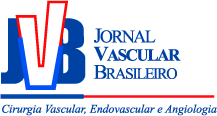Terapia alternativa para microvarizes e telangiectasias com uso de agulha
Alternative therapy for microvarices and telangiectasias with use of needle
Raimundo Rosendo de Oliveira; Eraldo Barbosa Calado; Diógenes Luis da Mota; André Filipe Vieira Pereira da Silva; Jennecy Sales Cavalcanti
Resumo
Palavras-chave
Abstract
Keywords
References
Beebe-Dimmer JL, Pfeifer JR, Engle JS, Schottenfeld D. The epidemiology of chronic venous insufficiency and varicose veins. Ann Epidemiol. 2005;15:175-84.
Cleave TL. Varicose veins, nature's error or man's?: Some implications of the Darwinian theory. Lancet. 1959;2:172-5.
Cornu-Thenard A, Boivin P, Baud JM, De-Vincenzi I, Carpentier PH. Importance of the familial factor in varicose disease: Clinical study of 134 families. J Dermatol Surg Oncol. 1994;20:318-26.
Evans CJ, Fowkes FG, Ruckley CV, Lee AJ. Prevalence of varicose veins and chronic venous insufficiency in men and women in the general population: Edinburgh Vein Study. J Epidemiol Community Health. 1999;53:149-53.
Iannuzzi A, Panico S, Ciardullo AV. Varicose veins of the lower limbs and venous capacitance in postmenopausal women: relationship with obesity. J Vasc Surg. 2002;36:965-8.
Maffei FH, Magaldi C, Pinho SZ. Varicose veins and chronic venous insufficiency in Brazil: prevalence among 1755 inhabitants of a country town. Int J Epidemiol. 1986;15:210-7.
Sadick NS. Predisposing factors of varicose and telangiectatic leg veins. J Dermatol Surg Oncol. 1992;18:883-6.
London NJ, Nash R. ABC of arterial and venous disease: Varicose veins. BMJ. 2000;320:1391-4.
Azizi MAA. Morfometria das fibras elásticas em colaterais varicosas do sistema de veias safenas. 2005.
Johnson Jr. G, Rutherford RB. Varicose veins: patients selection and treatment. Vascular surgery. 2000:2033.
Beebe HG, Bergan JJ, Bergqvist D. Classification and grading of chronic venous disease in the lower limbs: Aconsensus statement. Eur J Vasc Endovasc Surg. 1996;12:487-91.
Kistner RL, Eklof B, Masuda EM. Diagnosis of chronic venous disease of the lower extremities: the "CEAP" classification. Mayo Clin Proc. 1996;71:338-45.
Kistner RL. Definitive diagnosis and definitive treatment in chronic venous disease: a concept whose time has come. J Vasc Surg. 1996;24:703-10.
Labropoulos N, Giannoukas AD, Delis K. Where does venous reflux start?. J Vasc Surg. 1997;26:736-42.
Porter JM, Moneta GL. Reporting standards in venous disease: an update. International Consensus Committee on Chronic Venous Disease. J Vasc Surg. 1995;21:635-45.
Vin F. Varices, varicose veins. EMC Cardiologie Angéiologie. 2005;2:1-26.
Rutherford RB. Vascular surgery--comparing outcomes. J Vasc Surg. 1996;23:5-17.
Rutherford RB, Padberg FT Jr., Comerota AJ, Kistner RL, Meissner MH, Moneta GL. Venous severity scoring: an adjunct to venous outcome assessment. J Vasc Surg. 2000;31:1307-12.
Maffei FHA. Contribuição para o conhecimento da epidemiologia das varizes e da insuficiência venosa crônica dos membros inferiores. 1982.
Maffei FHA, Lastoria S, Yoshida WB, Rollo HA. Doenças vasculares periféricas. 2002.
Moraes L, Puech-Leão LE, Toledo OM. Varizes e telangiectasias: Utilidade da microangiografia na orientação terapêutica. Rev Ass Med Bra. 1962;1:5-9.
Mello NA. Síndrome das Varizes. Síndromes vasculares. 1999:265-94.
Thulesius O, Said S, Shuhaiber H, Neglen P, Gjores JE. Endothelial mediated enhancement of noradrenaline induced vasoconstriction in normal and varicose veins. Clin Physiol. 1991;11:153-9.
Rose SS, Ahmed A. Some thoughts on the aetiology of varicose veins. J Cardiovasc Surg. 1986;27:534-43.
Pitta GBB, Castro AA, Burihan E. Angiologia e cirurgia vascular: guia ilustrado. 2003.
Ungethuem ULG. Escleroterapia de varizes de membros inferiores por retropunção usando oleato de ethanolamina diluída em glicose hipertônica: análise de 12.560 casos. Anais. 2003.
Pinto-Ribeiro A. Varizes dos membros inferiores - 38 E: Escleroterapia de varizes. Doenças vasculares periféricas. 1987.
Epi Info's home page. .
Dean AG. Epi Info™ and Epi Map: current status and plans for Epi Info™ 2000. J Public Health Manag Pract. 1999;5:54-7.
Breu FX, Guggenbichler S. European Consensus Meeting on Foam Sclerotherapy, April, 4-6, 2003, Tegernsee, Germany. Dermatol Surg. 2004;30:709-17.
Beale RJ, Gough MJ. Treatment options for primary varicose veins--a review. Eur J Vasc Endovasc Surg. 2005;30:83-95.
Rabe E, Pannier-Fischer F, Gerlach H. Guidelines for sclerotherapy of varicose veins (ICD 10: I83.0, I83.1, I83.2, and I83,9). Dermatol Surg. 2004;30:687-93.
Correia ME, Oliveira AP. Complicações em escleroterapia. Angiologia e cirurgia vascular: guia ilustrado. 2003.
Green RM. An update on the diagnosis and treatment of varicose veins. Prim Care Update Ob/Gyns. 1995;2:107-10.
Sparey C, Haddad N, Sissons G, Rosser S, de Cossart L. The effect of pregnancy on the lower-limb venous system of woman with varicose veins. Eur J Vasc Endovasc Surg. 1999;18:294-9.
Golledge J, Quigley FG. Pathogenesis of varicose veins. Eur J Vasc Endovasc Surg. 2003;25:319-24.
Jiang P, van Rij AM, Christie RA, Hill GB, Thomson IA. Venous physiology in the different patterns of recurrent varicose veins and the relationship to clinical severity. Cardiovasc Surg. 2000;8:130-6.
Psaila J, Melhuish J. Viscoelastic properties and collagen content of the long saphenous vein in normal and varicose veins. Br J Surg. 1989;76:37-40.

